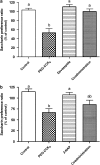PEGylated cholecystokinin is more potent in inducing anorexia than conditioned taste aversion in rats
- PMID: 18574458
- PMCID: PMC2567884
- DOI: 10.1038/bjp.2008.257
PEGylated cholecystokinin is more potent in inducing anorexia than conditioned taste aversion in rats
Abstract
Background and purpose: The physiological involvement of endogenous cholecystokinin (CCK) in the termination of feeding has been challenged by evidence of aversive effects of exogenous CCK8. We previously prolonged the anorectic effect of CCK by conjugation to polyethylene glycol (PEGylation) to produce PEG-CCK9. In this study, we investigated the ability of different doses of PEG-CCK9 to induce conditioned taste aversion (CTA) and satiety and identified the receptors involved in CTA induction.
Experimental approach: Induction of CTA, measured by the saccharin preference ratio determined in a two-bottle CTA procedure, and of satiety in adult male Wistar rats after intraperitoneal (i.p.) injection of different doses of PEG-CCK9 (1, 2, 4, 8, 16 or 32 microg kg(-1)) was compared. Devazepide (100 microg kg(-1)) and 2-NAP (3 mg kg(-1)), two selective CCK1-receptor antagonists, were co-administered i.p. with PEG-CCK9 (8 microg kg(-1)) and the CTA effects monitored.
Key results: PEG-CCK9 dose-dependently induced CTA, with a minimal effective dose of 8 microg kg(-1), whereas the minimal effective dose to induce satiety was 1 microg kg(-1). The CTA effects of PEG-CCK9 were completely abolished by i.p. administration of devazepide prior to PEG-CCK9 treatment and only partially abolished by administration of 2-NAP.
Conclusions and implications: Although PEG-CCK9-induced satiety and PEG-CCK9-induced CTA both increased with dose, the conjugate was more potent in inducing satiety, suggesting that the anorexia could not be completely attributed to the aversiveness of the drug. As observed with induction of satiety, PEG-CCK9-induced CTA was mediated by CCK1-receptors.
Figures



Similar articles
-
PEGylated cholecystokinin prolongs satiation in rats: dose dependency and receptor involvement.Br J Pharmacol. 2007 Oct;152(3):396-403. doi: 10.1038/sj.bjp.0707390. Epub 2007 Jul 9. Br J Pharmacol. 2007. PMID: 17618299 Free PMC article.
-
2-Naphthalenesulphanyl-L-aspartyl-2-(phenethyl) amide (2-NAP) and food intake in rats: evidence that endogenous peripheral CCK does not play a major role as a satiety factor.Br J Pharmacol. 1995 Nov;116(5):2371-4. doi: 10.1111/j.1476-5381.1995.tb15082.x. Br J Pharmacol. 1995. PMID: 8581271 Free PMC article.
-
PEGylation of cholecystokinin prolongs its anorectic effect in rats.Peptides. 2007 May;28(5):1003-11. doi: 10.1016/j.peptides.2007.02.009. Epub 2007 Feb 15. Peptides. 2007. PMID: 17379357
-
Dose-response effects of PEGylated cholecystokinin on the behavioral satiety sequence.Physiol Behav. 2009 Aug 4;98(1-2):198-204. doi: 10.1016/j.physbeh.2009.05.010. Epub 2009 May 22. Physiol Behav. 2009. PMID: 19465039
-
Cholecystokinin conditions flavor preferences in rats.Am J Physiol. 1991 Jan;260(1 Pt 2):R179-85. doi: 10.1152/ajpregu.1991.260.1.R179. Am J Physiol. 1991. PMID: 1992819
Cited by
-
Calcitonin Receptor Neurons in the Mouse Nucleus Tractus Solitarius Control Energy Balance via the Non-aversive Suppression of Feeding.Cell Metab. 2020 Feb 4;31(2):301-312.e5. doi: 10.1016/j.cmet.2019.12.012. Epub 2020 Jan 16. Cell Metab. 2020. PMID: 31955990 Free PMC article.
-
Beneficial effects of the novel cholecystokinin agonist (pGlu-Gln)-CCK-8 in mouse models of obesity/diabetes.Diabetologia. 2012 Oct;55(10):2747-2758. doi: 10.1007/s00125-012-2654-6. Epub 2012 Jul 20. Diabetologia. 2012. PMID: 22814764
References
-
- Baldwin BA, de la Riva C, Gerskowitch VP. Effect of a novel CCKA receptor antagonist (2-NAP) on the reduction in food intake produced by CCK in pigs. Physiol Behav. 1994;55:175–179. - PubMed
-
- Baldwin BA, Parrott RF, Ebenezer IS. Food for thought: a critique on the hypothesis that endogenous cholecystokinin acts as a physiological satiety factor. Prog Neurobiol. 1998;55:477–507. - PubMed
-
- Deutsch JA, Hardy WT. Cholecystokinin produces bait shyness in rats. Nature. 1977;266:196. - PubMed
-
- Ervin GN, Birkemo LS, Johnson MF, Conger LK, Mosher JT, Menius JA., Jr The effects of anorectic and aversive agents on deprivation-induced feeding and taste aversion conditioning in rats. J Pharmacol Exp Ther. 1995a;273:1203–1210. - PubMed
Publication types
MeSH terms
Substances
LinkOut - more resources
Full Text Sources
Research Materials

